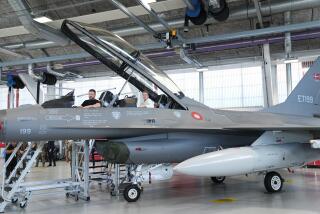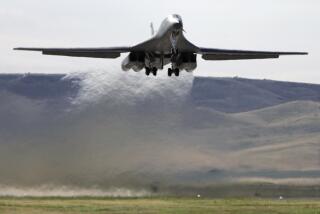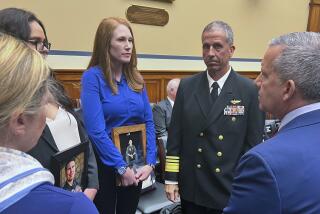F-14 Crashes Raise Questions of Age, Safety
MIRAMAR NAVAL AIR STATION, Calif. — Navy Lt. Jim Nolan can recall his first bad encounter with the F-14 Tomcat jet fighter as though it happened yesterday. It was 1992, and Nolan was flying the supersonic plane over the Virginia seacoast. Suddenly an engine caught fire.
Within seconds, the flames burned through the plane’s flight controls, leaving the aircraft unflyable and forcing Nolan into a risky bailout over the water. Rescued later by fishermen, he questioned whether he should continue flying at all.
Since then, Nolan, now a flight instructor who has flown his way through a spate of less serious emergencies, has come to accept this as part of the challenge of piloting the Tomcat, which was romanticized in the movie “Top Gun.”
“I still love the F-14,” he insisted.
But some are beginning to question whether the challenge is getting out of hand. Over the last few months, the F-14 has been catapulted onto the front page by a spate of major accidents, including a Jan. 29 crash in Nashville in which three civilians died.
At the same time, a series of recent tragedies--including Friday’s deadly collision of two Marine helicopters in North Carolina and the crash of an Air Force T-43A passenger jet carrying Commerce Secretary Ronald H. Brown and 34 others--has heightened concerns about safety in military aviation generally.
Military officials contend that these mishaps are aberrations. A preliminary probe by the Navy has found that there is “no common thread” in the recent F-14 crashes. Each has involved a different cause, from mechanical failure to pilot error.
Had it not been for the unusually grim crackup in Nashville, says Rear Adm. Dennis V. McGinn, who heads the naval aviation program, “about all that would have made the papers” concerning the other accidents “would have been a few paragraphs’ ” mention.
“Every single aircraft we have has idiosyncrasies,” he said.
Even so, Navy officials acknowledge that the F-14 is an aging warhorse in the Navy’s fighter fleet--it entered active service in 1973--and that a public impression is growing that time has passed it by.
Twenty-five years ago, the aircraft was state of the art. Now, in comparison to newer technology, it seems hard to maneuver in tight spots, prone to engine stall and sometimes physically taxing to control.
“The F-14 has for years had the reputation that you have to fly the engine, not the airplane,” said retired Rear Adm. James Winnefeld, referring to one of the airplane’s most controversial elements. “To fly the F-14 well, you have to be a damned good pilot.”
Four F-14s have crashed in the last three months. During the last four years, the crash rate for the F-14--the number of major mishaps for each 100,000 flying hours--has soared to more than twice that of the late 1980s, a development that Navy officials are unable to explain.
By contrast, the Navy’s newer fighters, such as the F/A-18 Hornet, have more advanced flight-control and safety systems, are more user-friendly--and incur fewer casualties as a result. The crash rate for the F/A-18 is four mishaps for every 100,000 hours, compared to the F-14’s 8.55 rate last year. (Commercial airliners, with different equipment and no need to simulate combat conditions, averaged 0.261 last year.)
In the wake of the recent crashes, the Navy has begun looking at whether the aircraft is becoming more prone to mechanical failures and whether its pilots are receiving enough training on safety. It is also studying ways to compensate for outdated technology.
But Adm. Jay L. Johnson, vice chief of naval operations, told Congress that the Navy has already decided not to proceed with one possible improvement--replacing the trouble-prone engine on the early-model F-14A--because that would be too costly on a plane that is being phased out.
Don M. Snider, a former Pentagon strategist, says the saga of the F-14 reflects the kind of delicate balancing act that today’s military planners now face between upgrading aging equipment and saving the money to buy newer weapons that can provide them with a future tactical edge.
With the Cold War over, Snider points out, the military services’ modernization budget has plunged to $39 billion, from $124 billion in 1986. With no immediate threat on the horizon, he contends, “it’s only prudent” for the Navy to channel its dollars to next-generation weapon systems.
The problem is that although the F-14 is being phased out, it remains the Navy’s premier fighter plane for the time being, and it still has a large mission. The distinctive twin-tailed fighter, with movable swept wings that can be pushed forward during landings, initially joined the force as an interceptor, and it continues to bear major responsibility for protecting American carrier battle groups from air attack.
It was part of the Navy force deployed in Operation Desert Storm and was used heavily in Bosnia, both to enforce the no-fly zone and to drop bombs on Bosnian Serb targets.
The jet’s primary weapon is a package of six Phoenix missiles, designed to shoot down approaching bombers from up to 50 miles away. Capable of flying at twice the speed of sound, the plane also has one of the largest and most powerful radars on any fighter. The Navy is equipping it with a new laser targeting system that will broaden its utility to make it a strike bomber as well.
In recent years, the F-14 gradually has been overshadowed by the much newer F/A-18 attack bombers, which number 800 and serve with the F-14 on aircraft carriers and land bases. But there are still about 330 F-14s in service, and they constitute a significant part of the Navy inventory.
They will continue to play a role for years. The early model F-14As will be in the scrapheap by 2004, but the newer model F-14Bs and Ds will remain a presence until 2010.
Even in the early 1970s, when the Navy introduced the Tomcat as the warplane of the future, there were problems with the F-14. Those have become only more conspicuous as better technology has come along.
The F-14 is heavy and mechanically complex. Its flaps, rudders and other control surfaces are controlled hydraulically rather than electrically, meaning that pilots must use a lot of muscle to operate them, tiring themselves more quickly.
A flaw in the design of the aircraft’s afterburner, which provides extra power for emergency acceleration, makes it possible for fuel to penetrate the burner’s liners, risking a fire.
And landings can be especially difficult because the plane is prone to stalling--and frequently goes into a “Dutch roll,” or unwanted yawing to one side--when the pilot slows down and points the nose up, as in approaching a carrier deck.
As a result, the Tomcat has become known as one of the more difficult fighters to fly.
“We lost three or four F-14s in flight training when I went through,” recalled one Tomcat veteran, now serving on an aircraft carrier in the Atlantic. “Planes would go thump, bang and you’d never hear from them again.”
Eventually, some improvements were made. But mechanical problems were cited as the chief cause of two of the four F-14 crashes this year, including one off the Southern California coast involving an afterburner malfunction. The Navy says the other two were due to pilot error.
Although Miramar’s Lt. Nolan says the stalled engines “are easy to restart,” Navy men warn that in a combat situation, even a temporary stall could prove deadly, ceding to an enemy pilot a crucial advantage in maneuvering.
“It’s not [a] good [characteristic] for a fighter,” said Cmdr. Pete Williams, now the “air boss” who supervises takeoffs and landings from the control tower of the aircraft carrier Enterprise. Even so, he insists, “I still think it is the plane to be in,” reflecting an aviator’s zest for challenge.
To be sure, as Williams points out, the Navy has taken some steps over the years to address the problems.
Later models of the F-14 were equipped with a more powerful engine, giving it a stronger, less stall-prone power plant.
And in 1994, after 11 F-14 crashes the previous year, the Navy began teaching its Tomcat pilots defensive flying, providing them with extra training in how to avoid situations in which the plane was likely to bolt out of control. The crash rate dropped accordingly.
Navy officials say privately that after the most recent crashes, they briefly considered phasing out the plane sooner but decided against it because they believe that the problems can be fixed.
Cmdr. Ted Carter, who oversees six fighter squadrons in the Pacific Fleet, says a 72-hour stand-down held last month to diagnose the F-14’s problems was a serious one. “We had a lot of soul-searching,” he recalled. “The most important thing we see was the loss of life.”
Partly as a result of the stand-down, officials have begun moving to modernize some of the F-14’s safety technology, with plans for a new digital flight-control system and a special new cockpit light to warn pilots when an engine seems likely to fail.
They also have clamped stringent restrictions on the speeds and maneuvers that pilots can attempt. And the use of afterburners on F-14Bs and F-14Ds now is limited to combat or emergency situations.
But experts say the changes may not make much difference for several years. Installation of the new digital flight-control system will not even begin until mid-1998, and will not be completed for a year after that.
And there is another consideration. Experts warn that if such restrictions eventually become permanent, the plane could become much less combat-effective, as already has happened with the CH-46 helicopter.
“In combat, you go to the limits of both the person and the aircraft,” noted Phillip Kolczynski of Newport Beach, a former F-4 pilot and aviation attorney. “If you can’t go as fast or pull as many Gs, you are going to have a theoretically hard time winning.”
Despite dozens of “fixes” that the Navy has made to the F-14 over the years, Kolczynski contends that the military generally has been laggard in eliminating defects. “Aviators expect to face a combat challenge but not one in defects,” he said.
But Navy officials argue that doing a lot more with the F-14 would require robbing the warplanes of the future. They prefer to husband resources for the Navy’s next big aviation venture, production of the F/A-18E/F--a new attack bomber that will come into the fleet in 2001.
The technology outlook beyond that is fuzzy. The last major push for a newer Navy plane--the radar-evading A-12 attack jet--was canceled by the Pentagon in 1991 after serious delays and cost overruns. Instead, the service is throwing its lot in with a new “joint” warplane that will serve all four services.
Robert F. Dunn, a retired vice admiral who was the Navy’s chief of air warfare, says he is worried that if the service does not find a way to balance its current constraints with its future needs, the Navy actually may find itself short of warplanes in coming years. “The way things are going now, I don’t see a solution,” he says.
Meanwhile, several hundred F-14 pilots will continue to fly the Tomcat, stressing the challenges rather than the difficulties of its advanced age.
With typical aviator’s nonchalance, Lt. Otto Sieber, an F-14 pilot aboard the Enterprise, dismisses all the talk about the dangerous “Dutch-roll” yaw during carrier landings.
“It’s almost something I don’t notice,” Sieber said.
Pine reported from Washington and from the Enterprise on station in the Atlantic. Vartabedian reported from Washington and from Miramar Naval Air Station.
* O.C. SERVICEMAN KILLED: Marine from Santa Ana among 14 dead in copter collision. A22
(BEGIN TEXT OF INFOBOX / INFOGRAPHIC)
Is the F-14 Safe?
A common measure of an airplane’s safety performance is its crash-rate--the number of major accidents it experiences for every 100,000 hours of flying. Here are the figures for the Navy’s F-14 Tomcat fighter:
Crash-rate: Number of major crashes for every 100,000 hours of flying.
‘96: 7.61*
* First four months
MAJOR CRASHES IN 1996
April 17: F-14B crashes near Oceana Naval Air Station, Va. Pilot and radar intercept officer were rescued. Probable cause: Mechanical problem.
Feb. 22: F-14A crashes in Persian Gulf after pilot makes mistake in performing a post-maintenance check. Pilot and radar intercept officer rescued. Official cause: pilot error.
Feb. 18: F-14D crashes off coast of Southern California, killing pilot and radar intercept officer. Probable cause: Fire in afterburner.
Jan. 29: F-14A crashes in Nashville residential area, killing pilot, radar intercept officer and three civilians, after pilot lost control due to vertigo. Official cause: pilot error.
Source: U.S. Navy
More to Read
Sign up for Essential California
The most important California stories and recommendations in your inbox every morning.
You may occasionally receive promotional content from the Los Angeles Times.











